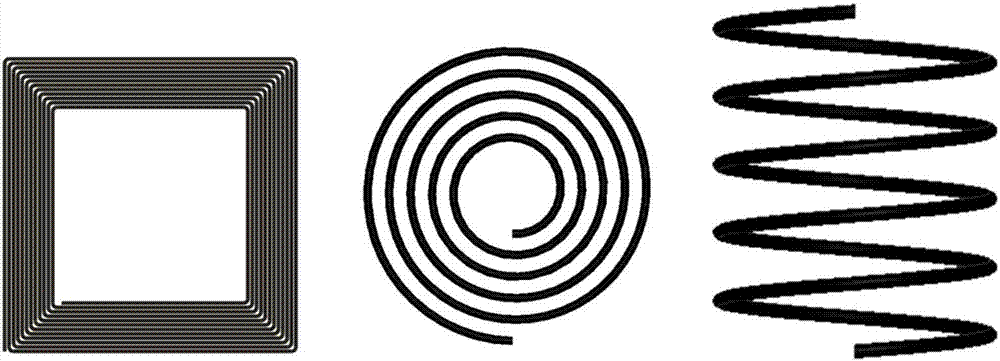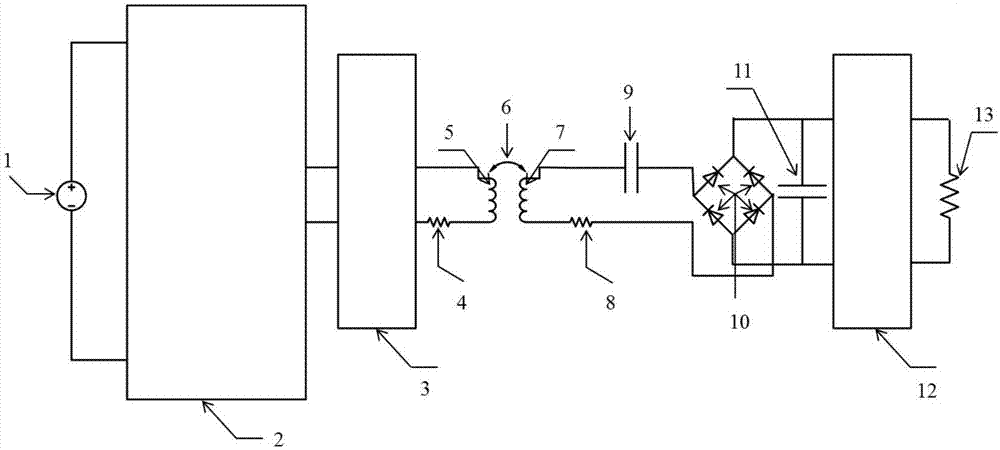Method for improving dynamic wireless charging mean efficiency
A wireless charging, average efficiency technology, applied in circuit devices, electrical components, etc., can solve problems such as low average charging efficiency, low average charging efficiency, and fluctuations in charging efficiency
- Summary
- Abstract
- Description
- Claims
- Application Information
AI Technical Summary
Problems solved by technology
Method used
Image
Examples
Embodiment 1
[0097] (1) Wind a transmission coil of appropriate size and specification according to the usage scenario in the actual wireless charging application. Such as figure 2 As shown, it is assumed that 600 strands of 0.1*0.1mm copper Litz wire are used to wind a transmitting and receiving coil with a side length of 50cm and a number of turns of 10, and the magnetic core is fixed on the coil mold to increase the self-inductance and mutual inductance of the coil.
[0098] (2) Assuming that the inductance of the two coils is 200uH at this time, and the internal resistance of the coil is 0.3Ohm, set the output voltage frequency f of the source terminal of the system 0 100kHz, C 2 =12.66nF, the matching circuit of the primary side is a capacitor of 12.66nF connected in series with the transmitting coil.
[0099] (3) if Figure 5 As shown, assuming that the spacing between the coils is 20cm when they are aligned, the mutual inductance is 0.24, and when the lateral offset is 20cm, the...
Embodiment 2
[0104] (1) Wind a transmission coil of appropriate size and specification according to the usage scenario in the actual wireless charging application. Such as figure 2 As shown, it is assumed that 400 strands of 0.1*0.1mm copper Litz wire are used to wind a transmitting and receiving coil with a side length of 40cm and a number of turns of 15, and the magnetic core is fixed on the coil mold to increase the self-inductance and mutual inductance of the coil.
[0105] (2) Assuming that the inductance of the two coils is 250uH at this time, and the internal resistance of the coil is 0.3Ohm, set the output voltage frequency f of the system source 0 80kHz, C 2 =15.83nF, the matching circuit of the primary side is a capacitor of 15.83nF connected in series with the transmitting coil.
[0106] (3) if Figure 5 As shown, assuming that the spacing between the coils is 15cm and the mutual inductance is 0.3, when the horizontal offset of the coils is 20cm, the mutual inductance betwee...
Embodiment 3
[0111] (1) Wind a transmission coil of appropriate size and specification according to the usage scenario in the actual wireless charging application. Such as figure 2 As shown, it is assumed that 500 strands of 0.1*0.1mm copper Litz wire are used to wind a transmitting and receiving coil with a side length of 45cm and a number of turns of 20, and the magnetic core is fixed on the coil mold to increase the self-inductance and mutual inductance of the coil.
[0112] (2) Assuming that the inductance of the two coils is 150uH at this time, and the internal resistance of the coil is 0.4Ohm, set the output voltage frequency f of the system source 0 150kHz, C 2 =7.5nF, the matching circuit on the primary side is a 7.5nF capacitor connected in series with the transmitting coil.
[0113] (3) if Figure 5 As shown, assuming that the spacing between the coils is 20cm and the mutual inductance is 0.25, when the angle of the receiving coil is offset by 40 degrees, the mutual inductanc...
PUM
| Property | Measurement | Unit |
|---|---|---|
| Inductance | aaaaa | aaaaa |
| Inductance | aaaaa | aaaaa |
| Inductance | aaaaa | aaaaa |
Abstract
Description
Claims
Application Information
 Login to View More
Login to View More - R&D
- Intellectual Property
- Life Sciences
- Materials
- Tech Scout
- Unparalleled Data Quality
- Higher Quality Content
- 60% Fewer Hallucinations
Browse by: Latest US Patents, China's latest patents, Technical Efficacy Thesaurus, Application Domain, Technology Topic, Popular Technical Reports.
© 2025 PatSnap. All rights reserved.Legal|Privacy policy|Modern Slavery Act Transparency Statement|Sitemap|About US| Contact US: help@patsnap.com



